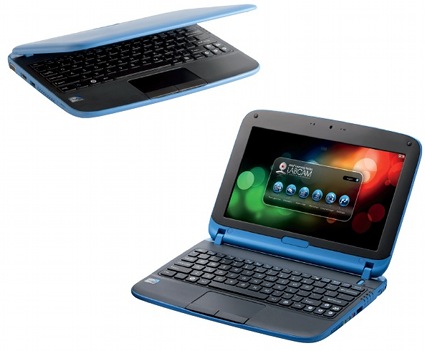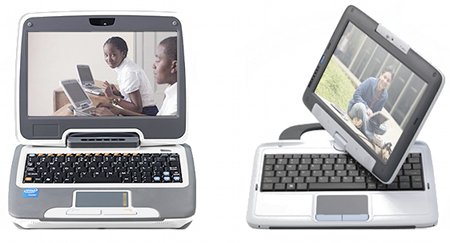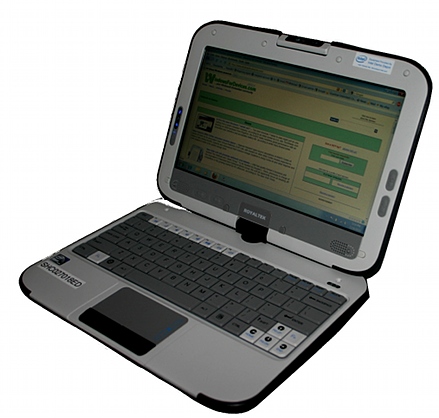Intel’s educational PC gets dual cores, 12-hour battery
Jan 11, 2012 — by LinuxDevices Staff — from the LinuxDevices Archive — 9 viewsIntel announced the fifth generation of its reference platform for education-focused portable PCs. The Classmate now features a dual-core Atom N2600 processor, delivering battery life of up to 12 hours, plus optional capacitive multitouch functionality, according to the company.
Intel's Classmate platform was originally introduced in 2007, and, as of the company's Jan. 11 announcement of an upgrade, is now in its fifth generation. Technologically, it provides underpinnings that are similar to any number of netbooks, but adds an integral carrying handle, a water-resistant keyboard with optional anti-microbial coating, and scratch-resistant surfaces.
OEMs basing products on the Classmate design are mostly small fry — Intel lists ASI, Babilon Technologies, Compumax, Computek, CTL, Equus, JP SaCouto, Koodoo, Lanix, M&A, Mustek, NTT System, Paradigit Computers, Positivo, RM, Sigong, Stone and Viper — but last year, Lenovo joined their number. And apparently, sales have been booming: In March 2011, Intel said more than three million Classmates had shipped worldwide, but the company's latest release says "more than six million."

Intel's new Classmate in its clamshell version
(Click to enlarge)
The fifth-generation Classmate hasn't changed drastically — again, it's available in either a rugged clamshell version or another whose screen flips over to convert into a tablet. However, the device now includes Intel's 32nm, dual-core N2600 ("Cedar Trail") processor.
Combined with available six-cell batteries, the power-sipping (3.5 Watt TDP) processor means the Classmate can now operate cordlessly for up to 12 hours (clamshell) or 11.5 hours (convertible), according to Intel. That's longer than any juvenile attention span we've ever heard of.

Intel's new Classmate in its convertible version
(Click to enlarge)
The other difference for this latest generation is the availability of a capacitive multitouch screen — with palm rejection — on the convertible version. Intel says the "textured touch screen, special stylus and handwriting recognition software create a 'write on paper' experience."
If cost is paramount, OEMs can still fit a resistive touchscreen instead. The convertible Classmate is available with resolutions of either 1024 x 600 or 1366 x 768 pixels, while the clamshell version offers only 1024 x 600 pixels.
It's hard to generalize about the Classmate's other features, since OEMs can decide whether to fit SSD (solid state disk) or hard disk (2.5-inch) storage. Similarly, the device's webcam may be either 0.3, 1.2, or 2.0 megapixels.
Meanwhile, the clamshell and convertible both include an SD slot, a VGA port, dual audio jacks, and two USB 2.0 ports. The design also allows OEMs to fit either a third USB 2.0 port or an HDMI port, according to Intel.
Expansion potential shames some "grown-up" portables in that there are both full- and half-size Mini PCI slots. The Classmate has a 10/100 Ethernet port, 802.11b/g/n wireless networking, and an available WiMAX option, Intel says.
Available with either Windows 7 or Linux, the Classmate now includes the (Intel-owned) McAfee AntiVirus software. Also available is trusted platform module (TPM)-based theft deterrence software, plus LabCam, which works with the webcam to provide "anti-shake features, media capture and management, noise filtering, digital archiving, and annotation."
Specifications listed by Intel for the new Classmate platform include:
- Processor — 1.6GHz Intel Atom N2600
- Chipset — NM10 I/O controller
- Memory — 1GB or 2GB of RAM
- Display — 10.1-inch screen; 1024 x 600 or (optional on convertible only) 1366 x 768 pixels
- Keyboard and touchpad — water-resistant, with optional anti-microbial coating
- Camera - 0.3, 1.3, or 2.0 megapixel camera
- Storage — 2.5-inch SATA devices (can be hard disk drives or solid state disks)
- Expansion:
- SD slot
- 1 x full-size PCI Mini slot
- 1 x half-size PCI Mini slot
- Networking:
- LAN — 10/100 Ethernet
- WLAN — 802.11b/g/n
- WAN — 3G or WiMAX (optional)
- Other I/O:
- VGA
- 2 x USB 2.0 (3 x USB 2.0 optional)
- HDMI (optional)
- audio — headphone out and microphone in
- Battery — three-cell (2200mAh) or six-cell (4400mAh or 5200mAh) battery; from 4.7 to 12 hours of operation depending on configuration
- Dimensions, including handle:
- clamshell — 10.6 x 8.3 x 1.34 inches (269 x 210.4 x 34.24mm)
- convertible — 10.55 x 8.26 x 1.53 inches (268 x 210 x 39mm)
- Weight — 3.5 pounds max. (1.6kg)
Background
Launched in 2007 as part of Intel's "World Ahead" program aimed at schoolchildren in emerging markets, the original Classmate was widely seen as a reply to One Laptop Per Child's (OLPC) Linux-based XO clamshell, which arguably launched the netbook phenomenon and had a similar global education focus.
The first Classmate ran on a mobile Celeron processor and offered a seven-inch screen. The netbook was upgraded in 2008 with a nine-inch screen and the addition of a hard disk drive, among other enhancements.

Third-generation (Atom N270) Classmate, including convertible version at right
In early 2009, Intel updated the Classmate again to the third generation featured above. This featured an Intel Atom N270 clocked at 1.6GHz, a larger 30GB HDD, and an optional convertible touchscreen version.

Intel's fourth-generation Classmate in a Royaltek version
The fourth-generation Classmate (pictured above) was announced in April 2010. Key improvements were the switch to an Atom N4xx processor and NM10 I/O controller, resulting in longer battery life, as well as a 1366 x 768 pixel screen option.
Further information
More information on Intel's new Classmate devices and related software may be found on the company's Learning Series website.
Jonathan Angel can be followed at www.twitter.com/gadgetsense.
This article was originally published on LinuxDevices.com and has been donated to the open source community by QuinStreet Inc. Please visit LinuxToday.com for up-to-date news and articles about Linux and open source.